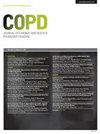Relationship Between Systemic Immune-Inflammation Index and Risk of Respiratory Failure and Death in COPD: A Retrospective Cohort Study Based on the MIMIC-IV Database
IF 3.1
3区 医学
Q1 Medicine
International Journal of Chronic Obstructive Pulmonary Disease
Pub Date : 2024-02-19
DOI:10.2147/copd.s446364
引用次数: 0
Abstract
Purpose: Chronic obstructive pulmonary disease (COPD) concurrent with respiratory failure (RF) is devastating, and may result in death and disability. Systemic immune-inflammation index (SII) is a new prognostic biomarker linked to unfavorable outcomes of acute coronary syndrome, ischemic stroke, and heart failure. Nonetheless, its role in COPD is rarely investigated. Consequently, this study intends to assess the accuracy of SII in predicting the prognosis of COPD.Patients and Methods: The clinical information was retrospectively acquired from the Medical Information Mart for Intensive Care-IV database. The outcomes encompassed the incidence of RF and mortality. The relationship between different SII and outcomes was examined utilizing the Cox proportional-hazards model and restricted cubic splines. Kaplan-Meier analysis was employed for all-cause mortality.
Results: The present study incorporated 1653 patients. During hospitalization, 697 patients (42.2%) developed RF, and 169 patients (10.2%) died. And 637 patients (38.5%) died during long-term follow-up. Higher SII increased the risk of RF (RF: HR: 1.19, 95% CI 1.12– 1.28, P< 0.001), in-hospital mortality (HR: 1.22, 95% CI 1.07– 1.39, P=0.003), and long-term follow-up mortality (HR: 1.12, 95% CI 1.05– 1.19, P< 0.001). Kaplan-Meier analysis suggested a significantly elevated risk of all-cause death (log-rank P< 0.001) in patients with higher SII, especially during the short-term follow-up period of 21 days.
Conclusion: SII is closely linked to an elevated risk of RF and death in COPD patients. It appears to be a potential predictor of the prognosis of COPD patients, which is helpful for the risk stratification of this population. However, more prospective studies are warranted to consolidate our conclusion.
Keywords: systemic immune-inflammation index, chronic obstructive pulmonary disease, respiratory failure, mortality, MIMIC-IV database
慢性阻塞性肺病患者全身免疫炎症指数与呼吸衰竭和死亡风险之间的关系:基于 MIMIC-IV 数据库的回顾性队列研究
目的:慢性阻塞性肺病(COPD)并发呼吸衰竭(RF)具有破坏性,可能导致死亡和残疾。全身免疫炎症指数(SII)是一种新的预后生物标志物,与急性冠状动脉综合征、缺血性中风和心力衰竭的不良预后有关。然而,它在慢性阻塞性肺病中的作用却鲜有研究。因此,本研究旨在评估 SII 预测慢性阻塞性肺病预后的准确性:临床信息从重症监护医学信息中心-IV 数据库中回顾性获取。结果包括RF发生率和死亡率。利用 Cox 比例危险模型和限制性立方样条对不同 SII 与预后之间的关系进行了研究。对全因死亡率采用了 Kaplan-Meier 分析法:本研究共纳入 1653 名患者。住院期间,697 名患者(42.2%)出现射频,169 名患者(10.2%)死亡。637名患者(38.5%)在长期随访中死亡。较高的 SII 会增加 RF(RF:HR:1.19,95% CI 1.12-1.28,P< 0.001)、院内死亡率(HR:1.22,95% CI 1.07-1.39,P=0.003)和长期随访死亡率(HR:1.12,95% CI 1.05-1.19,P< 0.001)的风险。Kaplan-Meier分析表明,SII较高的患者全因死亡风险明显升高(对数秩P< 0.001),尤其是在21天的短期随访期间:结论:SII 与慢性阻塞性肺病患者射频和死亡风险的升高密切相关。结论:SII 与慢性阻塞性肺病患者射频和死亡风险的升高密切相关,似乎是慢性阻塞性肺病患者预后的潜在预测指标,有助于对这一人群进行风险分层。关键词:全身免疫炎症指数、慢性阻塞性肺病、呼吸衰竭、死亡率、MIMIC-IV 数据库
本文章由计算机程序翻译,如有差异,请以英文原文为准。
求助全文
约1分钟内获得全文
求助全文
来源期刊

International Journal of Chronic Obstructive Pulmonary Disease
RESPIRATORY SYSTEM-
CiteScore
5.10
自引率
10.70%
发文量
372
审稿时长
16 weeks
期刊介绍:
An international, peer-reviewed journal of therapeutics and pharmacology focusing on concise rapid reporting of clinical studies and reviews in COPD. Special focus will be given to the pathophysiological processes underlying the disease, intervention programs, patient focused education, and self management protocols. This journal is directed at specialists and healthcare professionals
 求助内容:
求助内容: 应助结果提醒方式:
应助结果提醒方式:


